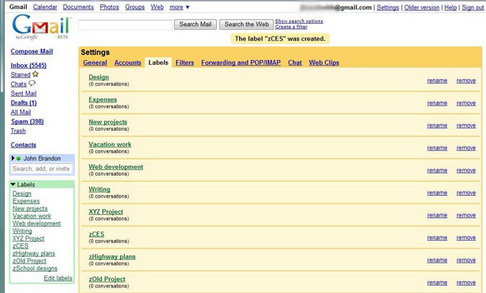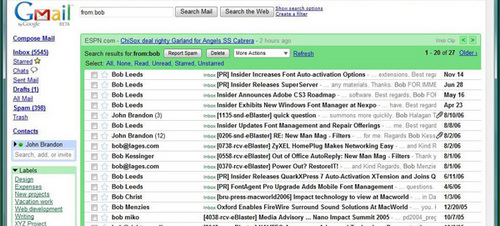Advanced Gmail technology
Gmail mail service gives you a lot of useful features, from sending and receiving to retrieving messages when needed. Although in webmail mode as well as being used through Microsoft Outlook mail management program, you can arrange messages for easy-to-read purposes, making the work quickly resolved. Here are some experiences of using this free service effectively.
Use Label (label) instead of Folder

With Label function, users can set Gmail to automatically group for incoming messages. To do so, simply open the message and click on More Options, select New Label. Then enter the label name for the message. Completing the operation, all messages with the same address will be categorized into a naming group on the left side of the screen.
Similar to the steps for creating a separate folder in Outlook software, this function is often used every time the project starts, in which information exchange is a necessary condition to support the work.
Initializing Filter (mail filter)

You can use this feature to specify automatic mail forwarding modes, or immediately delete without reading if not needed.
Create a mail filter, click on the Create a Filter item located near the search box. Next enter the data you want, such as the sender's name or address, and then click Next. At the end of this step, the Gmail system will help you review all received messages, automatically store messages of people you have not seen for a long time or mark important news messages quickly. .
The secret to using keywords

Adhere to the intuitive, easy-to-use interface, Gmail's search function provides you with an effective way to list messages based on sender's name, letter title and other factors. To exploit this utility, you need to choose the right keyword in the search.
To review all messages sent by someone, enter the search box for their email address. Alternatively, you can type in the syntax From: NameName .
Similarly, you can find a single message if you remember a piece of content, in this case, enter the Subject: InnerDung syntax .
For those who regularly work via email, the number of hundreds of letters received each month, the syntax is limited to the time limit After: Month / Day / Year and Before: Month / Day / Year proved very helpful in pointing out when the letter was received.
In addition, you can use the Label: InnerDung syntax to find tagged messages.
You should read it
- Instructions for creating incoming mail filters on Gmail
- Great way to search for Gmail, search for super cool things
- Gmail supported 'Label in Label'
- How to search for text messages on iPhone and iPad
- How to Move Mail to Another Folder in Gmail
- What is the volume label for a volume?
- How to merge text, merge Mail Merge messages in Word 2016
- How to classify Gmail mailboxes quickly?
May be interested
- Tips to help you master Gmail on Android
 gmail is now the most popular and most used email service. so, knowing more gmail tips will help us get more out of gmail's useful features.
gmail is now the most popular and most used email service. so, knowing more gmail tips will help us get more out of gmail's useful features. - How to update the new Gmail interface if your Gmail has not been upgraded
 google has just updated gmail and it's the biggest new design ever since. new gmail design will bring many security features such as security mode to add 2-factor authentication or set a self-destruct time for email. the fake email alerts are also clearer, the new tasks tool to upload to-do and manage lists right in the email.
google has just updated gmail and it's the biggest new design ever since. new gmail design will bring many security features such as security mode to add 2-factor authentication or set a self-destruct time for email. the fake email alerts are also clearer, the new tasks tool to upload to-do and manage lists right in the email. - Why is Gmail filtering good spam?
 most people who have used many different email services have confirmed that gmail has a fast, smooth and compact interface, especially spam filtering very well. so why does gmail have such good email filtering capabilities? recently google revealed a part of the technology it is applying.
most people who have used many different email services have confirmed that gmail has a fast, smooth and compact interface, especially spam filtering very well. so why does gmail have such good email filtering capabilities? recently google revealed a part of the technology it is applying. - This is the new look of Gmail
 earlier, google announced it was about to change gmail's style. this update not only changes the interface but also adds new features in the inbox.
earlier, google announced it was about to change gmail's style. this update not only changes the interface but also adds new features in the inbox. - 3 good tips to help you manage Inbox on Gmail more effectively
 on gmail there are many hidden features that even long-time users won't discover. in the article below, network administrator will introduce you to 3 good tips for managing mailboxes on gmail quickly and more efficiently.
on gmail there are many hidden features that even long-time users won't discover. in the article below, network administrator will introduce you to 3 good tips for managing mailboxes on gmail quickly and more efficiently. - 11 great extensions for Gmail on Firefox
 gmail gave way to google inbox and google chrome won the battle with mozilla firefox. but for those loyal to the two most memorable brands on the internet, firefox and gmail, will definitely like these gmail extensions for firefox.
gmail gave way to google inbox and google chrome won the battle with mozilla firefox. but for those loyal to the two most memorable brands on the internet, firefox and gmail, will definitely like these gmail extensions for firefox. - How to receive Gmail notifications on Desktop screen?
 receiving gmail notifications on the desktop is one of gmail's cool and new features. if you are a regular checker of gmail, this feature is really useful for you.
receiving gmail notifications on the desktop is one of gmail's cool and new features. if you are a regular checker of gmail, this feature is really useful for you. - In a few weeks Gmail will change to new clothes, will it get new users?
 google is planning to launch a new design for its web-based gmail application interface. in an email to managers of the g suite, the company said there will be several new features for regular gmail accounts. google promises that gmail on the web will be new and more neat with features like smart reply, email delays (snooze) and offline support.
google is planning to launch a new design for its web-based gmail application interface. in an email to managers of the g suite, the company said there will be several new features for regular gmail accounts. google promises that gmail on the web will be new and more neat with features like smart reply, email delays (snooze) and offline support. - 14 useful tools for Gmail should not be ignored - P2
 in the previous article, we introduced you to 7 useful tools with gmail, helping users to manage and use email more professionally. and in this article, we will continue to introduce more browser-based utilities when using gmail.
in the previous article, we introduced you to 7 useful tools with gmail, helping users to manage and use email more professionally. and in this article, we will continue to introduce more browser-based utilities when using gmail. - How to create a job assignment table on Gmail?
 gmail is currently the most popular online mailing and receiving service. and we can fully utilize gmail to turn it into a job assignment and management board.
gmail is currently the most popular online mailing and receiving service. and we can fully utilize gmail to turn it into a job assignment and management board.










 MS PowerPoint - Lesson 4: PowerPoint design template
MS PowerPoint - Lesson 4: PowerPoint design template MS PowerPoint: Tips or making rich slide shows
MS PowerPoint: Tips or making rich slide shows MS PowerPoint - Lesson 5: Create a manual presentation slide
MS PowerPoint - Lesson 5: Create a manual presentation slide Calculate the subtotal of the list on Excel
Calculate the subtotal of the list on Excel MS PowerPoint - Lesson 6: Drawing Toolbar
MS PowerPoint - Lesson 6: Drawing Toolbar MS PowerPoint - Lesson 7: PowerPoint design template
MS PowerPoint - Lesson 7: PowerPoint design template